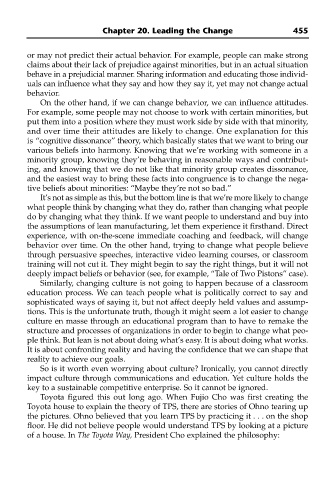Page 487 - The Toyota Way Fieldbook
P. 487
Chapter 20. Leading the Change 455
or may not predict their actual behavior. For example, people can make strong
claims about their lack of prejudice against minorities, but in an actual situation
behave in a prejudicial manner. Sharing information and educating those individ-
uals can influence what they say and how they say it, yet may not change actual
behavior.
On the other hand, if we can change behavior, we can influence attitudes.
For example, some people may not choose to work with certain minorities, but
put them into a position where they must work side by side with that minority,
and over time their attitudes are likely to change. One explanation for this
is “cognitive dissonance” theory, which basically states that we want to bring our
various beliefs into harmony. Knowing that we’re working with someone in a
minority group, knowing they’re behaving in reasonable ways and contribut-
ing, and knowing that we do not like that minority group creates dissonance,
and the easiest way to bring these facts into congruence is to change the nega-
tive beliefs about minorities: “Maybe they’re not so bad.”
It’s not as simple as this, but the bottom line is that we’re more likely to change
what people think by changing what they do, rather than changing what people
do by changing what they think. If we want people to understand and buy into
the assumptions of lean manufacturing, let them experience it firsthand. Direct
experience, with on-the-scene immediate coaching and feedback, will change
behavior over time. On the other hand, trying to change what people believe
through persuasive speeches, interactive video learning courses, or classroom
training will not cut it. They might begin to say the right things, but it will not
deeply impact beliefs or behavior (see, for example, “Tale of Two Pistons” case).
Similarly, changing culture is not going to happen because of a classroom
education process. We can teach people what is politically correct to say and
sophisticated ways of saying it, but not affect deeply held values and assump-
tions. This is the unfortunate truth, though it might seem a lot easier to change
culture en masse through an educational program than to have to remake the
structure and processes of organizations in order to begin to change what peo-
ple think. But lean is not about doing what’s easy. It is about doing what works.
It is about confronting reality and having the confidence that we can shape that
reality to achieve our goals.
So is it worth even worrying about culture? Ironically, you cannot directly
impact culture through communications and education. Yet culture holds the
key to a sustainable competitive enterprise. So it cannot be ignored.
Toyota figured this out long ago. When Fujio Cho was first creating the
Toyota house to explain the theory of TPS, there are stories of Ohno tearing up
the pictures. Ohno believed that you learn TPS by practicing it . . . on the shop
floor. He did not believe people would understand TPS by looking at a picture
of a house. In The Toyota Way, President Cho explained the philosophy:

